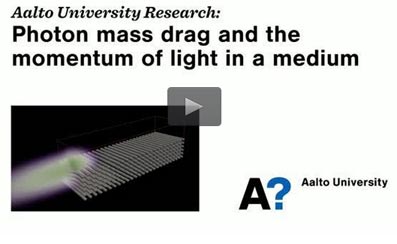Transfer of atomic mass with a photon solves the momentum paradox of light

Photon mass drag and the momentum of light in a medium. Credit: Mikko Raskinen / Aalto University
In a recent publication, Aalto University researchers show that in a transparent medium each photon is accompanied by an atomic mass density wave. The optical force of the photon sets the medium atoms in motion and makes them carry 92% of the total momentum of light, in the case of silicon.
The novel discovery solves the centennial momentum paradox of light. In the literature, there has existed two different values for the momentum of light in the transparent medium. Typically, these values differ by a factor of ten and this discrepancy is known as the momentum paradox of light. The difference between the momentum values is caused by neglecting the momentum of atoms moving with the light pulse.
To solve the momentum paradox the authors prove that the special theory of relativity requires an extra atomic density to travel with the photon. In related classical computer simulations, they use optical force field and Newton´s second law to show that a wave of increased atomic mass density is propagating through the medium with the light pulse.
The mass transfer leads to splitting of the total momentum of light into two components. The fields' share of momentum is equal to the Abraham momentum while the total momentum, which includes also the momentum of atoms driven forward by the optical force, is equal to the Minkowski momentum.
“Since our work is theoretical and computational it must be still verified experimentally, before it can become a standard model of light in a transparent medium. Measuring the total momentum of a light pulse is not enough but one also has to measure the transferred atomic mass. This should be feasible using present interferometric and microscopic techniques and common photonic materials”, researcher Mikko Partanen says.
Potential interstellar applications of the discovery
The researchers are working on potential optomechanical applications enabled by the optical shock wave of atoms predicted by the new theory. However, the theory applies not only to transparent liquids and solids but also to dilute interstellar gas. Using a simple kinematic consideration it can be shown that the energy loss caused by the mass transfer effect becomes for dilute interstellar gas proportional to the photon energy and distance travelled by light.
“This prompts for further simulations with realistic parameters for interstellar gas density, plasma properties and temperature. Presently the Hubble's law is explained by Doppler shift being larger from distant stars. This effectively supports the hypothesis of expanding universe. In the mass polariton theory of light this hypothesis is not needed since redshift becomes automatically proportional to the distance from the star to the observer”, explains Professor Jukka Tulkki.
Media Contact
All latest news from the category: Physics and Astronomy
This area deals with the fundamental laws and building blocks of nature and how they interact, the properties and the behavior of matter, and research into space and time and their structures.
innovations-report provides in-depth reports and articles on subjects such as astrophysics, laser technologies, nuclear, quantum, particle and solid-state physics, nanotechnologies, planetary research and findings (Mars, Venus) and developments related to the Hubble Telescope.
Newest articles

First-of-its-kind study uses remote sensing to monitor plastic debris in rivers and lakes
Remote sensing creates a cost-effective solution to monitoring plastic pollution. A first-of-its-kind study from researchers at the University of Minnesota Twin Cities shows how remote sensing can help monitor and…

Laser-based artificial neuron mimics nerve cell functions at lightning speed
With a processing speed a billion times faster than nature, chip-based laser neuron could help advance AI tasks such as pattern recognition and sequence prediction. Researchers have developed a laser-based…

Optimising the processing of plastic waste
Just one look in the yellow bin reveals a colourful jumble of different types of plastic. However, the purer and more uniform plastic waste is, the easier it is to…


